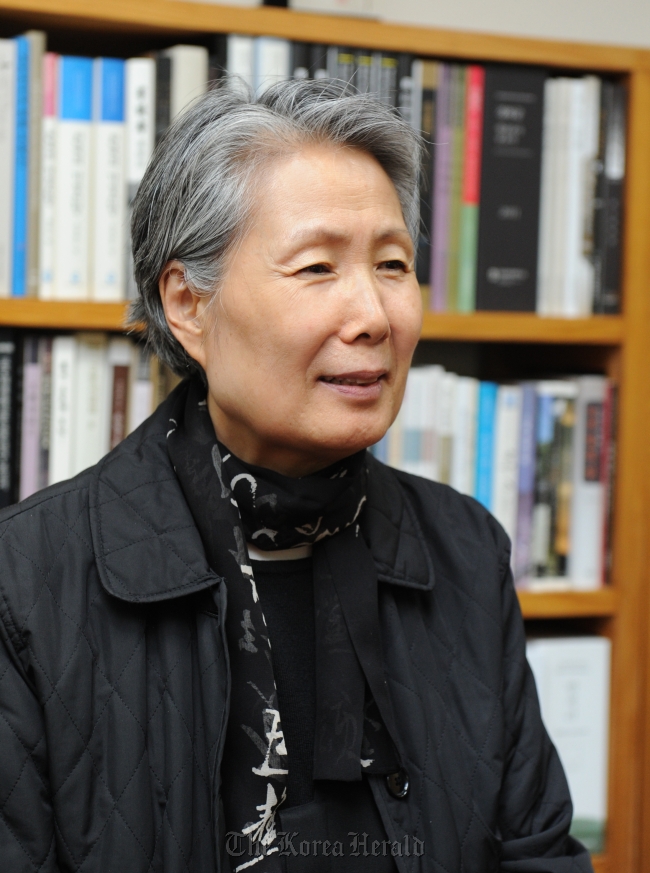The newly appointed chief of the state heritage agency on Wednesday said she is ready to protect a set of endangered petroglyphs in the outskirts of Ulsan, North Gyeongsang Province, which has been her lifelong project.
“The Bangudae Petroglyphs, part of the Daegokcheon Stream Petroglyphs, are the beginning of all Korean arts, and therefore, one of the most urgent items that we must preserve,” said Byun Young-sup, administrator of the Cultural Heritage Administration, who took office on Monday.
During her meeting with the press Wednesday, the former art and archaeology professor at Korea University and head of a civic association for the preservation of the Bangudae Petroglyphs, said the government should not abandon the pieces facing ruin, making it impossible for future generations to enjoy.
 |
Cultural Heritage Administration chief Byun Young-sup (CHA) |
The rock face of Bangudae, measuring 3 meters in height and 10 meters in length, is located on the lower part of a 30-meter cliff that faces north. The engraved images include numerous humans, animals, ships, tools and unknown figures. Animals, both sea animals and land animals, are depicted as being pregnant, indicating the ancient people’s earnest desire for securing food and fertility, according to UNESCO.
The artifacts are National Treasure No. 285 and were listed on the UNESCO World Heritage Tentative List in 2011.
UNESCO acknowledged that the pieces are regarded as particularly valuable because of their adjacent location and for a series of linked prehistoric and historic sites from diverse periods located between the two rock carvings.
However, when the heritage was discovered in 1971, it instantly became a subject of dispute since the level of water storage at the Sayeon Dam, constructed in 1965 without knowledge about the petroglyphs’ existence, submerged the artifact under water for eight months a year. The pieces are visible for only four months, and such a pattern of repeated submerging in water has been eroding and damaging the artifact.
 |
Daegokcheon Bangudae Stream Petroglyphs (CHA) |
Activists have demanded the government limit the level of the water to protect the petroglyphs from being permanently destroyed but the local government has been reluctant since the water in the dam has been the staple source of living for more than 1 million residents in Ulsan and its outskirts.
“The petroglyphs are special because they are the oldest art pieces depicting whaling. We can also understand the lifestyle of the late Neolith-Bronze era,” Byun said.
She admitted that it is an irony that she now heads the CHA, which has been the subject of her denouncement in the past for turning a blind eye to the possible destruction of the artifacts.
“If the surrounding environment does not support the long life of the enlisted items, the UNESCO World Heritage’s subsidiary body will never inscribe the petroglyphs to the actual list,” Byun said. “If that happens, it will be an international embarrassment,” she added.
“Korea currently has fewer items enlisted on the UNESCO list than Japan, which means that we are still a bit behind in willingness to protect and preserve. I am willing to do whatever it takes to protect the artifacts,” Byun said.
By Bae Ji-sook (
baejisook@heraldcorp.com)






![[Exclusive] Hyundai Mobis eyes closer ties with BYD](http://res.heraldm.com/phpwas/restmb_idxmake.php?idx=644&simg=/content/image/2024/11/25/20241125050044_0.jpg)
![[Herald Review] 'Gangnam B-Side' combines social realism with masterful suspense, performance](http://res.heraldm.com/phpwas/restmb_idxmake.php?idx=644&simg=/content/image/2024/11/25/20241125050072_0.jpg)

